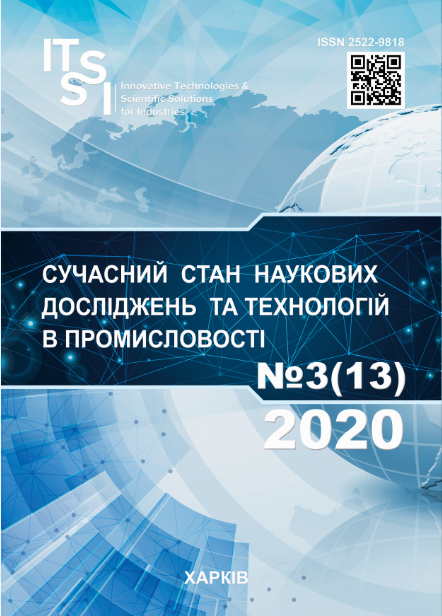OPTIMIZATION OF RISKS OF THE INVESTMENT PORTFOLIO OF ART OBJECTS ACCORDING TO THE LEVEL OF FINANCIAL SECURITY OF ART INVESTING IN THE LOCAL ART MARKET
DOI:
https://doi.org/10.30837/ITSSI.2020.13.095Keywords:
investment portfolio of art objects, art investing, financial security of art investing, risks of art investing, investment attractiveness of art objects, multiplier of investment attractiveness of an art object, investment potential of an art objectAbstract
The article is devoted to the study of theoretical and methodological principles and development of practical recommendations for optimizing the risks of the investment portfolio of art objects according to the level of financial security of art investing in the local market. The subject of the study is a set of theoretical, methodological and practical aspects for optimizing the risks of the investment portfolio of art objects according to the level of financial security of art investing in the local market. The purpose of the article is to develop theoretical and methodological provisions and substantiate practical recommendations for optimizing the risks of the investment portfolio of art objects according to the level of financial security of art investing in the local market. Objectives: to investigate and systematize the conceptual and categorical apparatus of financial security of art-investment; to develop a methodical approach to assessing the level of investment attractiveness of an art object according to the level of financial security of art investing; to offer analytical and applied support for optimizing the risks of the investment portfolio of art objects according to the level of financial security of art investing in the local art market. During the research the following methods were used: abstract-logical analysis, theoretical generalization, system and statistical analysis, system and statistical analysis, economic-mathematical methods, graphical method. The essence and genesis of the concept of investment as an economic category in the context of the development of the history of economic thought are determined, on the basis of which the specific features of the investment process are generalized, the concept of art-investment is defined. Analytical and applied support for minimizing the risks of the investment portfolio of art objects at the level of financial security of art investment in the local art market and its testing on the example of the author's investment portfolio of art objects of contemporary Ukrainian artists. Conclusions. Analytical and applied support for minimizing the risks of the investment portfolio of art objects by the level of financial security of art investing in the local art market was developed. It allows to determine the investment potential of the art object by the components of financial security of art investment by the parameters of the internal environment based on the assessment of the multiplier to assess the investment attractiveness of art objects; to establish the priority of investing in art object as part of the investment portfolio; to position each art object on the matrix taking into account the emotional effect of ownership of the art object for the investor.
References
Momot T., Momot, D. (2018), "Art-industry market infrastructure: the analysis of modern structure and functions", Innovative Technologies and Scientific Solutions for Industries, No. 2 (4), P. 34–44. DOI: https://doi.org/10.30837/2522-9818.2018.4.034
Kene, F. (1960), Farmers: Selected Economic Studies [Fermery: Izbrannyye ekonomicheskiye pronzvedennya], Moscow, From-in social-zkon. lit., 567 p.
Smith, A. (2007), Research on the nature and causes of the wealth of peoples [Issledovaniye o prirode i prichinakh bogatstva narodov], Moscow, Eksmo, Series: Anthology of Economic Thought, 960 p.
Marks, K. (1978), Capital. Criticism of Political Economy [Kapital. Kritika politicheskoy ekonomii], Vol. I : Capital production process, Moscow, Politizdat, 891p.
Fisher, I. (1930), "The Theory of Interest" [Electronic resource], New York, available at : http//www.ekonlib.org/library/YPDBooks/Fisher/fshTol.html
Keynes, J. M. (1973), "General Theory of Employment, Interestand Money", Collected Writings of Jоhn Maynard Keynes, Vol. VII, London, Macmillan.
Markowitz, H. M. (1956), Portfolio Selection. Efficient Diversification of Investments, NewYork, Wiley.
Modigliani, F. M. Miller (1958), The Cost of Capital, Corporation Finance and Theory of Investment, American Economic Review, 48 p.
Sharpe, W. (1985), Investment, NewYork, PrenticeHall.
Sharpe W., Alexander, G., Bailey, J. (1999), Investments [Investitsii] : transl. from English, Moscow, INFRA-M, 1028 p.
Dunning, J. (1990), "The eclectic paradigm as an envelope for economic and business theories of MNE activity", International Business Review, Vol. 9, P. 163–190.
Porter, M. E. (1990), The Competitive Advantage of Nations, N. Y., The Free Press, A Division of Macmillan, Inc., 895 p.
Friedman, M. (2006), Capitalism and Freedom [Kapitalizm i svoboda] : Per. from English, Moscow, New publishing house, 240 p.
Bodie, Z., Kane, A., Markus, A. (2008), Principles of Investment [Printsipy investitsiy], Moscow, Williams, 984 p.
Masse, P. (1971), Criteria and Methods for Optimal Investment Determination [Kriterii i metody optimal'nogo opredileniya kapitalovlozheniya], Moscow, 503 p.
Downloads
How to Cite
Issue
Section
License
Copyright (c) 2020 Daryna Momot

This work is licensed under a Creative Commons Attribution-NonCommercial-ShareAlike 4.0 International License.
Our journal abides by the Creative Commons copyright rights and permissions for open access journals.
Authors who publish with this journal agree to the following terms:
Authors hold the copyright without restrictions and grant the journal right of first publication with the work simultaneously licensed under a Creative Commons Attribution-NonCommercial-ShareAlike 4.0 International License (CC BY-NC-SA 4.0) that allows others to share the work with an acknowledgment of the work's authorship and initial publication in this journal.
Authors are able to enter into separate, additional contractual arrangements for the non-commercial and non-exclusive distribution of the journal's published version of the work (e.g., post it to an institutional repository or publish it in a book), with an acknowledgment of its initial publication in this journal.
Authors are permitted and encouraged to post their published work online (e.g., in institutional repositories or on their website) as it can lead to productive exchanges, as well as earlier and greater citation of published work.














